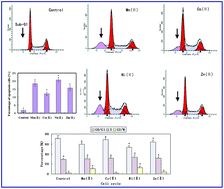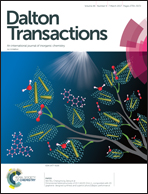Inhibitory effects of different substituted transition metal-based krebs-type sandwich structures on human hepatocellular carcinoma cells†
Abstract
Two new transition metal-substituted Krebs-type sandwich structures of (H2imi)2[(BiW9O33)2{W0.5Ni0.5(H2O)}2{Na4 (H2O)14}{Ni(H2O)3}2]·17.5H2O (3) and (H2imi)2[(BiW9O33)2(WO(OH))2Na4(H2O)13(Zn(H2O)3)2]·12H2O (4) (imi = iminazole) were synthesized using the aqueous solution method, and their structures were identified using elemental analysis, infrared, and ultraviolet spectoscopy, thermogravimetry, and single crystal X-ray diffraction. Two polyoxometalates (POMs) were isomorphic with manganese (Mn2+) and cobalt (Co2+) compounds, (Himi)2[(BiW9O33)2(W(OH)2)2(Mn(H2O)3)2(Na3(H2O)14)]·16H2O (1) and (H2imi)2[(BiW9O33)2(W(OH)2)2(Co(H2O)3)2Na4 (H2O)14]·17H2O (2), which were reported in a previous study. This study continued with the determination of the inhibitory effects of four POMs on human hepatic carcinoma Hep G2 cells. Four compounds were used to compare their effects on the measurement of the sub-G1 (sub-G1 hypodiploid cell population) DNA content, the analysis of nuclear morphology, and the protein expression. The results showed that compound 3 (IC50 = 25.6 ± 1.07 μmol L−1) had a much higher anti-tumor activity than compounds 1 and 4 in Hep G2 cells. Compound 2 had the lowest anti-tumor activities in Hep G2 cells. However, compound 3 showed much higher cytotoxicity than compounds 1, 2 and 4 in QSG-7701 cells. Compound 4 had the lowest cytotoxicity of all of these compounds. These findings indicate the effective relationship between the metal components and structures, and their antitumor activities in Hep G2 cells.



 Please wait while we load your content...
Please wait while we load your content...